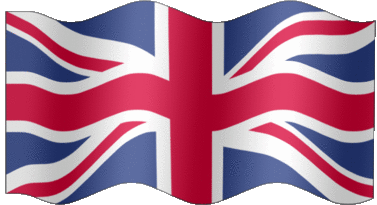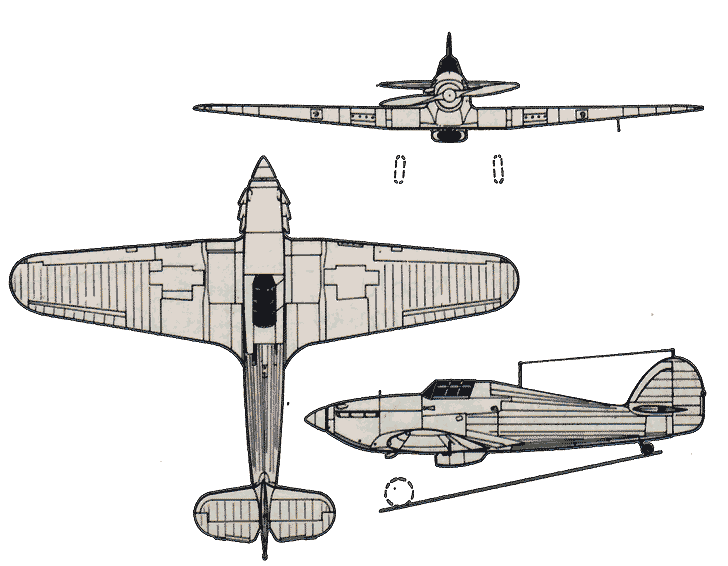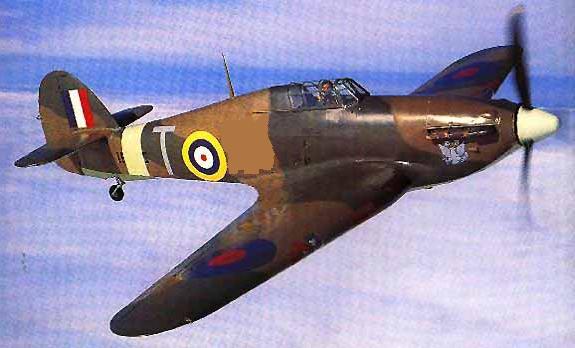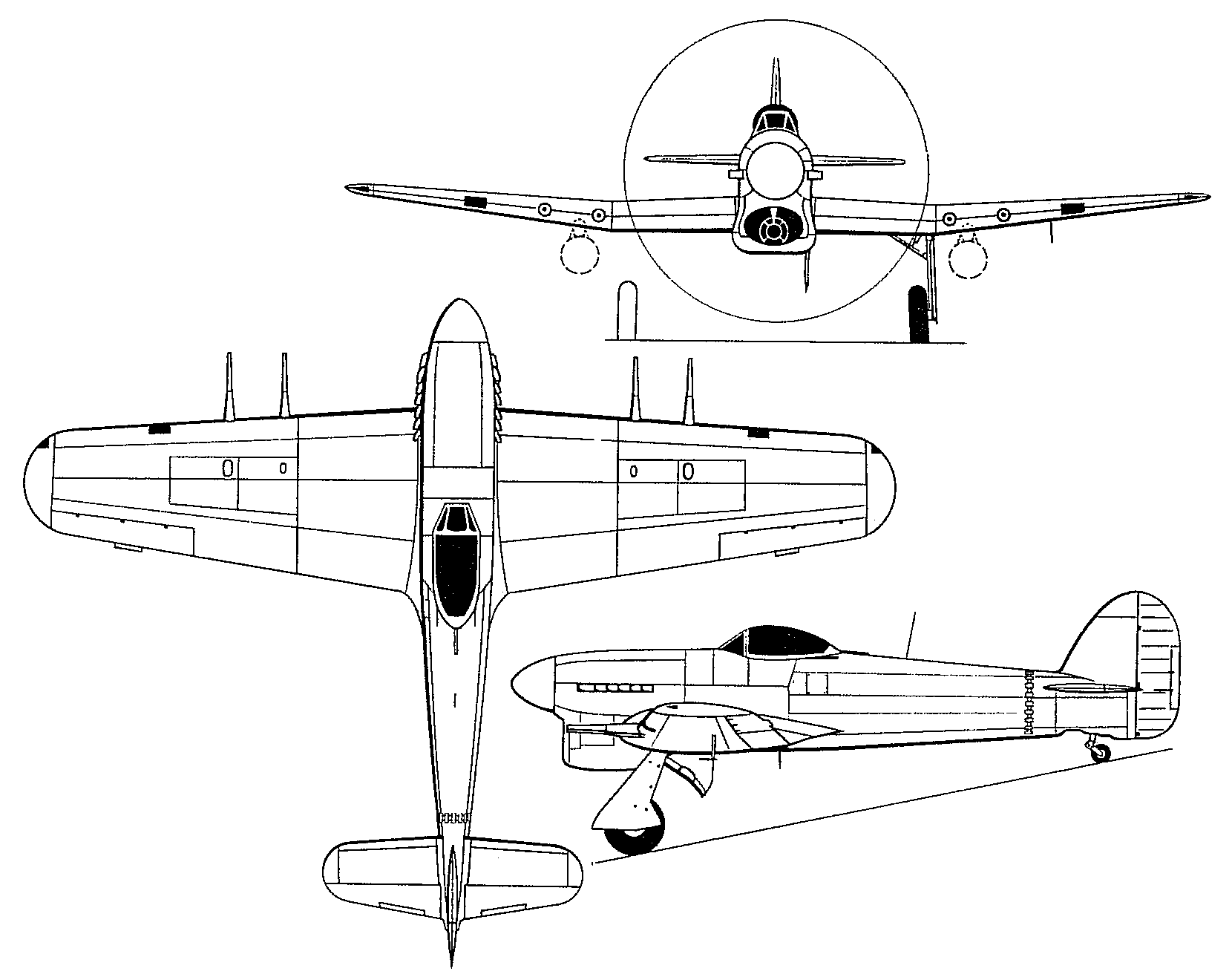
Terran British Royal Air Force. | Hawker
Hurricane/Typhoon. | 
Terran British Royal Air Force. |
|---|
The Hawker Hurricane was the First fighter monoplane to join the Royal Air Force and the First combat aircraft adopted by that arm capable of exceeding 300 mph in level  | | Schematical View Of The Hurricane Fighter. |
|---|
 |  | | A Hurricane Fighter of 61ᶴᵀ Aerial Group, River Bend Civil Defense. | Typhoon Variant; Note The Gull-Style Rather Than Straight Wings. |
|---|
flight. The Hurricane shouldered the lion's share of Britain's defense during the "Battle of Britain," and was largely responsible for the successful outcome of this conflict for the defending forces, equipping more than three-fifths of R.A.F. Fighter Command's squadrons. The Hurricane also proved to possess an astounding propensity for adaptation, and the multifarious roles that it undertook earned for it the distinction of being the most versatile of single seat Warplanes to emerge from the Second World War. Today, they serve as sector patrol and perimeter guards for Spitfires.The original Hurricane specifications was the work of Sydney CAMM, who began its design in 1934. The prototype First took to the air on November 6,1935, at Brooklands, and the initial production Hurricane I entered RAF service in December 1937, with No. 111 Squadron. Powered by the famous Rolls-Royce Merlin engine, it became the First RAF monoplane fighter with an enclosed cockpit and retractable undercarriage, its First fighter capable of a level speed in excess of 300 mph (483 km/h), and its First eight-gun fighter.The Royal British Conglomerate resurrected the craft for Civil Defense shortly after the introduction of the P-40 Warbird, but delays in converting the hydro-cell turbine engine (it was too long to fit originally) delayed deployment until AFTER the deployment of the Reisien (Zero) Fighter. Never the less, the Hurricane has proven highly effective since deployment.The Hurricane was, partly, intended as pure R&D; The British wanted to see what types of technology the craft could support. It was also conceived for pure defense work. Consequently, every single sortie IS a science experiment, and the craft maintains continuous telemetry, tactical, and etc. info transfers to a ground station; Essentially, a back-up black box. This has proven highly useful, as even the loss of a craft develops more data; The pilot, also, has essentially a second set of eyes on his or her heads down displays (though many bemoan the "back seat drivers").The Hurricane has yet to see combat, but NOT for lack of trying; On 21 April, 2211, at 2031 local, an Ator Malcont group landed a small shuttle on Vitrov with the intention of slave raiding. The presence of a flight of Hurricanes (8 ships) forced them to STAY landed until ground forces found them and killed them all. 02 hostages (of 30 total) were also killed in the rescue.VariantsTyphoonThe Hawker Typhoon is a ground-attack variant of the Hurricane; It has been slightly re-designed with gull-style wings (the inboard wing dips very slightly down, the outboard wing rises relatively sharply). The historic Typhoon was in fact a fully new plane; However, Kranick-Desel Aero Space's engineers felt that the wing re-design was sufficient and the cost/benefit ratio of a total re-design was nill; In fact, it would be totally cost-prohibitive.Main User: Royal British Conglomerate (still called Great Britain)Other Users:European CollectiveGreater African RepublicCentral Asian UnionMars Central ColonyName: Hawker HurricaneModel Type: WarbirdClass: Pursuit/FighterCrew: One; Two-seater models are also available.Passengers: None.MDC By Location: |
Fuselage-
Engine Compartment-
Cockpit Canopy-
Wings (2)- | 150
190
100
175 | Tailerons (2) & Rudder-
Props (3)-
Landing Struts (3)-
| 90 each
50 each
50 each
|
| Speed and Statistical Data: |
Maximum speed: 340 mph (547 km/h)
Cruising speed: 307 mph (494 km/h)
Range In The Air: 1,000 miles (1,480 km)
Service Ceiling: 40,000 ft. (12,192 m)
Climb Rate: 4,500 ft/min (9 minutes to service ceiling)
Takeoff Length: 150 ft unassisted.
Landing Length: 50 ft unassisted.
Height: 8 ft. 9 in. (2.66 m)
Wingspan: 40 ft. 0 in. (12.19 m)
Length: 32 ft. 3 in. (9.82 m)
Weight: 7,127 Ib. | Operational Weight: 8,470 lb. (3,841 kg)
Fuel Capacity Internal: About 2,000 lbs.
Fuel Capacity External: 50 gallons.
Cargo: Pilot's supplies only.
Power System: One Rolls-Royce Merlin MVI Hydro-Cell Radial Engine; Output:1,850 h.p. (1,379 kw) at 21,000 ft. (6,400 m).
Flight Systems:Primary: Standard Grav Pods.Secondary: Aero-Foil Effect.
Cost and Availability: 15,000credit each; Routinely available.
Black Market Cost and Availability: 5,000 to 50,000credit each; Rarish. |
| Weapons Systems:The main M-3 Machinegun can easily enough be replaced with similar weapons (thought the M-550d requires the barrel aperture to be widened, which KDAS does not support). A common selection is the L-02a (which KDAS does support), since it supplies the plane with 2 and a half times the ammo. |
1. Eight .50 Caliber M-3 Machineguns: The general purpose weapon of the Warbird series; A fully automatic, heavy machinegun has been around since the early 20ᵗʰ Century on Earth, and nearly identical ones have existed just about everywhere. In all mechanical functions, the Regult Series Battle Pods auto-cannon is so similar that some would call them identical; Only the caliber is significantly different (and thus, the engineering is SLIGHTLY different). The addition of Depleted Uranium rounds to the available inventory has added to the lethality of the .50's significantly. Also, during the War with the Regent, Plasma-662 propellant was developed; The charge was reduced to exactly emulate the effect of Cordite propellant, so it does NOT effect the damage. Purpose: Anti-Personnel/Armor Purpose: Anti-Personnel/Armor
Damage: Lead (Ball) shot: 7D6 Per round; Depleted Uranium rounds: 1D6 times 10 MD per round; Burst fire only.
Rate of Fire: Burst fire only; Fires a 10 round burst per pilots attacks per melee. .50's used on the Warbird series were specially modified at the factory to be burst fire only.
Range: 600 feet
Payload: 50,000 rounds are normally carried- That's 10,000 bursts.
Weight: 50 lbs
Cost and Availability: 5,000 credits; Occasionally available. Highly sought after, and made by a wide number of black marketeers.
Ammo Cost and Availability: Ball rounds: 800 to 1,000 credits for a box of 50; Routinely available. DU rounds: Up to 100 thousand credits for a box of 50; Rare. Highly sought after. | 2. Wing Mounted Weapons Systems: The plane can carry up to 3 pods (1 each wing and 1 undercarriage).A) M-7 Rocket Launcher: 24 2-inch rocket tubes in 12 rows of 4 each. Each rocket tube has 4 rockets.
Purpose: Heavy Assault
M.D.: Each rocket does 2D6 M.D.
Rate of Fire: Volleys of 6 or 12 times pilots attacks per melee.
Range: 12,000'
Payload: 96 per pod. Up to 6 pods can be carried.B) M-11 Torpedo Pod: An ASW torpedo pod. Carries the Mk-82 Airborne Torpedo essentially a modified version of the Mk-81 Submarine Launched Torpedo. The initial launch is by a nothing so complicated as releasing it from the latches that hold it to the pylon. The on board hydro-cell motor then takes over as soon as the torpedo splashes. Each pod hold 3 Mk-82's.
Purpose: Offensive/Anti-Ship
M.D.: 4D6 times 10 per torpedo
Blast Radius: 40'
Maximum Range: 80 miles
Minimum Range: 5 miles
Rate of Fire: 1 torpedo per pilots attacks per melee.
Payload: Each pod holds 3 Mk-82's.C) M-12 Fuel Pod: Essentially a modified version of the M-11 Torpedo Pod. In this case, however, it is used as a fuel pod to double the normal range of the craft.D) C-441 Canister Pod: Basically a hollowed out version of the M-7 pod, used to drop highly sensitive and extensive messages. A nose-mounted device using GPS or laser detection guides the pod to within ⅛ᵗʰ of an inch of the intended target. |
| Features: |
- Radar: Combat grade radar. Range 100 miles, can track up to 200 individual targets. 90% reliability (no reliability against unfriendly stealthed air vehicles, 10% against unfriendly ground vehicles).
- Electronic Counter Measures (ECM): These systems disrupt enemy radar and tracking systems, making it difficult for them to lock onto the ship with weapons. The countermeasures give the Mecha a +3 to dodge, +2 to strike and +1 on initiative in combat.
- ESM: Radar Detector. Passively detects other radars being operated.
- AJP: Active Jamming Pod. Causes-25% to detection but when it is active, other vehicles/bases can detect that it is jamming, and some missiles will home in on jamming signals. Jamming also causes a-4 penalty to all radar guided weapons.
- GPS: Standard tracking device. Ties into the Blue Force Tracker.
- Full Range Optic Sensory Suite: Infrared, ultra violet, Magnification, night sight, color filters, thermal imager. Range is about 200 miles for MOST sensors.
- Motion Detector: Activates a loud wailing when an object is coming at the user fast, and a soft ringing if it's coming slowly. Activation ranges must be specified by the pilot.
- FLIR/SLIR: Forward and Side Looking Infrared. Allows pilot to get visuals on targets at night.
- Blue Force Tracker: Identifies friend from foe. Overlays the information on both the radar and HUD, ensuring that friendly forces are not accidentally targeted.
- Video Camera: 20,000 times zoom lens, records all data observed by the unit. 5,000 hours of recording available.
- Grav Clamps: Grav pods in the wheels of the landing gears allow the planes to adhere to the hulls of Warships and the exteriors of SOME buildings up to a full 90 degrees angle (nose up, down, or to the sides doesn't matter).
- Survival Pack: A pack of simpler emergency survival supplies: Pup tent, sleeping bag, black light, GPS, First aid kit (bandages, gauze, bandage tape, pads, antiseptic/analgesic), plasma torch (for small repairs and starting fires), repair kit (with MDC Repair Spray), sewing kit (a small spool of thread and 5 needles), 7 star flares (250 foot apogee), 100 feet of black or brown parachute cord (150 lbs tensile strength; This is in addition to several hundred feet from their parachute itself), 2-5 days rations, 2 gallons water, water purification kit (good for about 10 gallons), self-inflating lifevest (15# buoyancy), manual-inflation survival raft (for at-sea abandonment).
- Fire resistance: Fires external to the craft are not felt at all.
| - Combat/Targeting Computer: Records all enemy and friendly activity over the course of time; Can replay that activity for the pilot, assign target designation numbers, and track likely damage based on mathematical formulas (i.e. "Right leg red" badly damaged/destroyed, "head green" not damaged, etc). Displays this information as a pop up in the HUD as requested by the pilot.
- MRA 6 Radios: Allows real time, continuous radio link up with friendly forces in the area via satellite relay over laser radio signals, preventing jamming, and automatically encrypts/decrypts same to prevent eavesdropping.
- Type-11 wide band radios: Effective 10 mile range, auto encrypt/decrypt. Works on standard radio band wavelengths, so it can still be jammed (if the enemy knows the frequencies).
- HUD: Displays targeting, airspeed, artificial horizon, and true direction information directly in front of the pilot.
- Variable Tint Cockpit Canopy: Adjusts tinting to light conditions, up to an including a black dot if the sun is directly on the pilots face (only covers eyes).
- Decoys: Specially modified Mini-Missiles used as decoys; Burning globs of magnesium/aluminum alloy to confuse both radar AND heat sensory systems, as well as creating a lot of smoke to obscure the Mecha. NOTE: Though the modified mini-missiles combine smoke flares, AMC/FDs, and LDP's, they aren't powerful enough for use with Destroids/Guardians/Etc. Reduce effects by 20% against smart missiles (add +20% to rolls for smart missiles).
- Effect:
- 01-50: Enemy missile or missile volley detonates in chaff cloud- Missiles are all destroyed.
- 51-75: Enemy missile or missile volley loses track of real target and veers away in wrong direction (may lock onto another target).
- 76-00: No effect, missile is still on target.
- Also note that the chaff cloud will also blind nearby heat sensors (and optically based sensors at night) for 1 melee. They will suffer the following penalties: Reduce melee attacks/actions, and combat bonuses by half. Also, a cloud of smoke approximately 252 feet wide and high by about 1 half-mile long.
- Duration: 1D4 melee rounds.
- Rate of Fire: Once per melee.
- Payload: 6 chaff/flares.
|
Combat Bonuses from Hawker Hurricane/Tornado Fighter Elite:- 4 additional attacks per melee.
- One additional Attack Per melee at levels 3, 6, 9, and 12 with any additional bonuses for the pilot.
- +3 Strike to aircraft, +3 against ground targets.
- +4 Dodge, +3 dodge ground-launched anti-aircraft missiles (in addition to normal +4 dodge).
- +3 Dodge to left/right (with propeller spin/in addition to standard dodge).
- +3 Dive Dodge (in addition to standard dodge).
- +1 Roll.
|